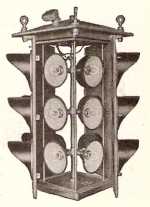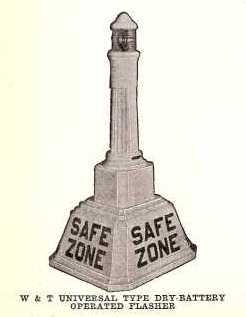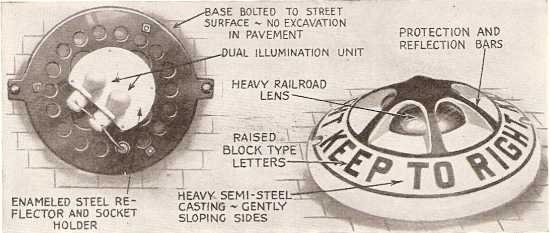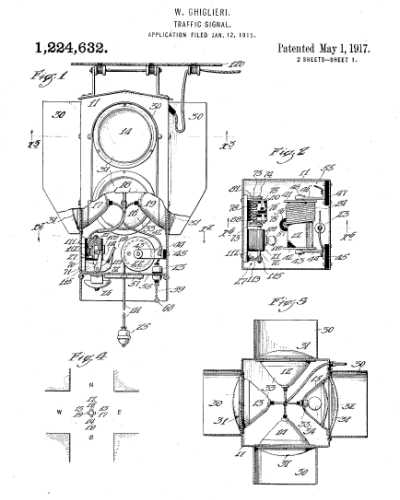Willis Lamm's
|
| History of Traffic Signal Design |

| Imaginations at Work! |
|
As soon as cities discovered the advantages that electrically illuminated traffic signals provided to aid their often beleaguered traffic police, inventors set to work on producing more effective yet economical traffic control devices, and in doing so came up with a host of new innovations.
City streets often had a chaotic mix of street car, motor car, delivery truck and even occasional horse drawn traffic. Busy intersections were common places for congestion and accidents. During the day traffic police kept this chaos to a minimum. Late at night when traffic was light and visibility was poor, different devices were tried in an attempt to delineate the center of intersections. The idea was that traffic was to keep to the right of the center of each intersection. When turning, traffic would make orderly turns around the center of the intersection so as not to pull into oncoming cross street traffic. This issue in of itself led to great debate among traffic officials.
The two sides of the debate held opposing views over the issue of beacons versus mushroom lights to delineate the centers of intersections. And even within the beacon and mushroom camps there were divided opinions. One camp argued that beacons placed on pedestals in the centers of intersections were necessary to require careless motorists to comply with traffic circulation regulations. The argument was that a motorist couldn't "short cut" across a pedestal mounted beacon as one could over a mushroom. In addition, the physical size of pedestal mounted beacons allowed them to be powered by dry cell batteries - a prospect that in some instances was less expensive than trenching the street to install permanent wiring. But within that camp came a division as to whether beacons should flicker (flash) or be steadily lit. One side argued that flickering beacons would attract greater attention whereupon the other side argued that it was easier to determine the position of a beacon from a distance when it produced a steady light.
Within the mushroom camp there was a division as to whether mushrooms should be designed so as to not cause any damage to any vehicle that struck them versus designs that would command more "respect" from drivers at the peril of damaging their own vehicles.
In the meanwhile inventors were busy developing ideas for improved "stop and go" signals. One example involved inventor William Ghiglieri who came up with an idea for a signal that would automatically change colors at preset intervals. Ghiglieri was awarded a patent in 1917 for a traffic signal that included electrically illuminated red and green lenses, but the timing mechanism ran like a clock using a weight suspended from a cord that was rolled onto a drum. Apparently the signal controller had to be "wound" on a regular basis. This patent was one of the earliest issued for automatically timed electrically illuminated signals and from the patent records, was the first use of the term "traffic signal" in a patent application description. |

 The other camp favored mushroom signals. The argument in favor of mushrooms was that these devices created less of a hazard to an errant driver of a motorcar or horse drawn vehicle who might miscalculate a turn while in traffic and strike a pedestal mounted beacon. The counter argument was that pedestal mounted beacons were easier to see from a distance and that it was better to brush a beacon pedestal than to disregard a mushroom and turn into oncoming traffic.
The other camp favored mushroom signals. The argument in favor of mushrooms was that these devices created less of a hazard to an errant driver of a motorcar or horse drawn vehicle who might miscalculate a turn while in traffic and strike a pedestal mounted beacon. The counter argument was that pedestal mounted beacons were easier to see from a distance and that it was better to brush a beacon pedestal than to disregard a mushroom and turn into oncoming traffic.
 Over time the argument became moot as automatically timed traffic signals became commonplace in controlling traffic in busy intersections and electric beacons were suspended over intersections rather than be subject to being struck by vehicles.
Over time the argument became moot as automatically timed traffic signals became commonplace in controlling traffic in busy intersections and electric beacons were suspended over intersections rather than be subject to being struck by vehicles.